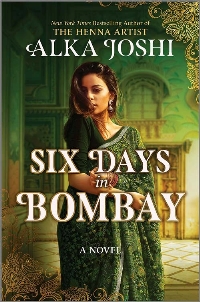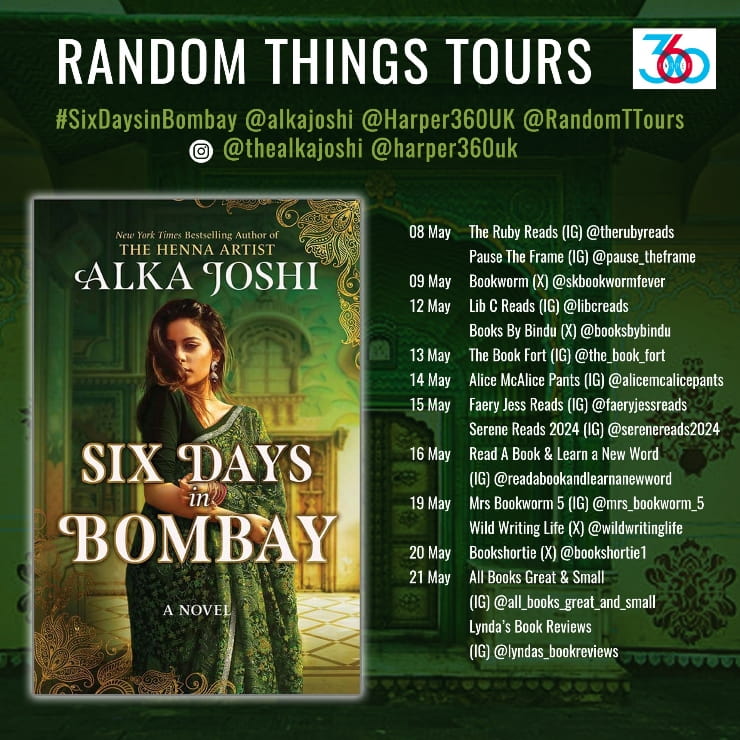Blog tour: Six Days in Bombay by Alka Joshi

This post is part of a blog tour organised by Random Things Blog Tours. I received a free copy of the book in return for an honest review.
‘When renowned painter Mira Novak arrives at Wadia hospital in Bombay after a miscarriage, she’s expected to make a quick recovery, and her nurse, Sona, is excited to learn more about the vivacious artist who shares her half-Indian identity.
‘Sona, yearning for a larger life, finds herself carried away by Mira’s stories of her travels and exploits and is shocked by accounts of the many lovers the painter has left scattered throughout Europe. When Mira dies quite suddenly and mysteriously, Sona falls under suspicion, and her quiet life is upended.
‘The key to proving Sona’s innocence may lie in a cryptic note and four paintings Mira left in her care, sending the young woman on a mission to visit the painter’s former friends and lovers across a tumultuous Europe teetering toward war.
‘On the precipice of discovering her own identity, Sona learns that the painter’s charming facade hid a far more complicated, troubled soul.’

In Six Days in Bombay, by Alka Joshi, it’s 1937 and young nurse Sona Falstaff is captivated by one of her patients, artist Mira Novak, who’s in hospital following a miscarriage.
Sona and Mira are both in their twenties and half-Indian (Sona’s estranged father is English, while Mira’s is Czech), but their similarities end there. Mira is a free spirit who’s lived and loved in a few different countries, whereas Sona has never left India and has been extensively sheltered by her mother, to whom she’s devoted.
When Mira dies under mysterious circumstances, Sona finds herself unemployed and unmoored. However, Mira has left her three paintings to deliver to old friends and lovers in Prague, Paris, and Florence, offering an opportunity to see some of the world – and maybe even confront the father she hasn’t seen since she was three years old.
I found Six Days in Bombay a compelling read. The part of the book that’s set in India is especially vibrant, with details that appeal to all the senses, but I also enjoyed experiencing Europe with Sona, even if her last two stops felt a little short! I additionally liked reading about Mira’s artistic practice, including the contemporary artists and styles that inspired her, and the messages they conveyed about her subjects.
I quickly became invested in Sona’s story and the everyday comings and goings at the hospital where she worked, including her interpersonal relationships with colleagues and patients besides Mira. It was particularly interesting, and shocking (though, sadly, not surprising) to see how British healthcare workers and patients were better-treated than Indian ones who were just as, or even more, qualified.
As Sona is mixed-race, or half-half, a major, fascinating theme of the book is how she struggles with her identity. Her British heritage has helped her forge ahead with her nursing career (Indian nurses have to train for longer, and are paid less), and having a British passport smooths her way when she travels.
However, despite having lived in India, mostly just with her mother, her whole life, Sona’s undeniable Britishness means she’s never been popular with her Indian peers, and this has only got worse in recent years, with talk of Independence in the air. This is one reason she’s taken with Mira, who seems to have conquered her inner conflicts by embracing India in her life and art.
The other reason, as alluded to above, is that Mira is bold and adventurous where Sona is dutiful and meek (though she’s not afraid to put handsy doctors in their place!). Mira’s admissions thrill and scandalise Sona, and make her realise she wants more from her life.
A big lesson Sona eventually learns is that people are complicated, and can be more than one thing. For much of the story, as she hasn’t seen much of life, she’s very moralistic, and sees people in black and white.
She’s grown up hating her father for falling in love with her mother when he was already married, then returning to his family in England, without considering how that situation might have come about (human fallibility, essentially), or how his other family might have felt.
As Sona sorts people into “good” and “bad”, she feels disillusioned when the friends of Mira’s she tracks down talk about the artist’s hurtful and selfish actions against them, and when Dr Stoddard – a characterful elderly patient she befriends, and accompanies for the first part of her trip – tells her about something he did in the past that wasn’t very nice.
It’s gratifying to see Sona develop a more nuanced understanding of other people. At the same time (without giving too much away), at the end we find out she’s done something her younger self would have condemned in the strongest terms, and I wished she hadn’t let go of her ideals to quite that extent.
Six Days in Bombay is rich, absorbing, and thought-provoking.
